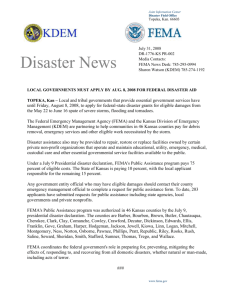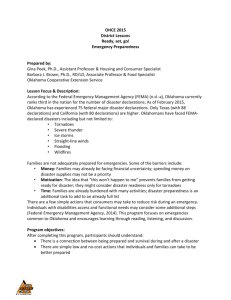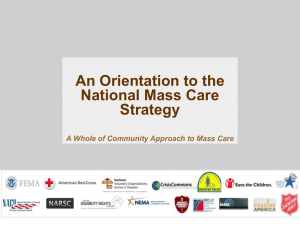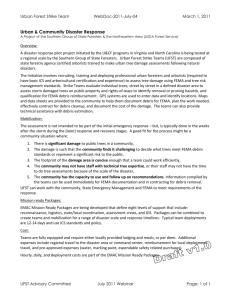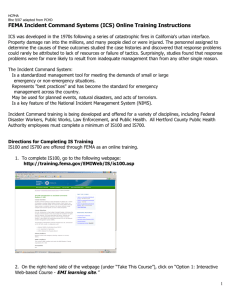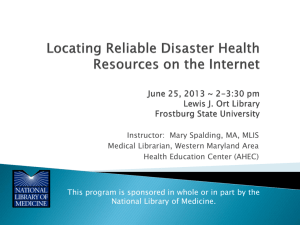CONTINUING EDUCATION REQUIREMENTS for RENEWAL
advertisement
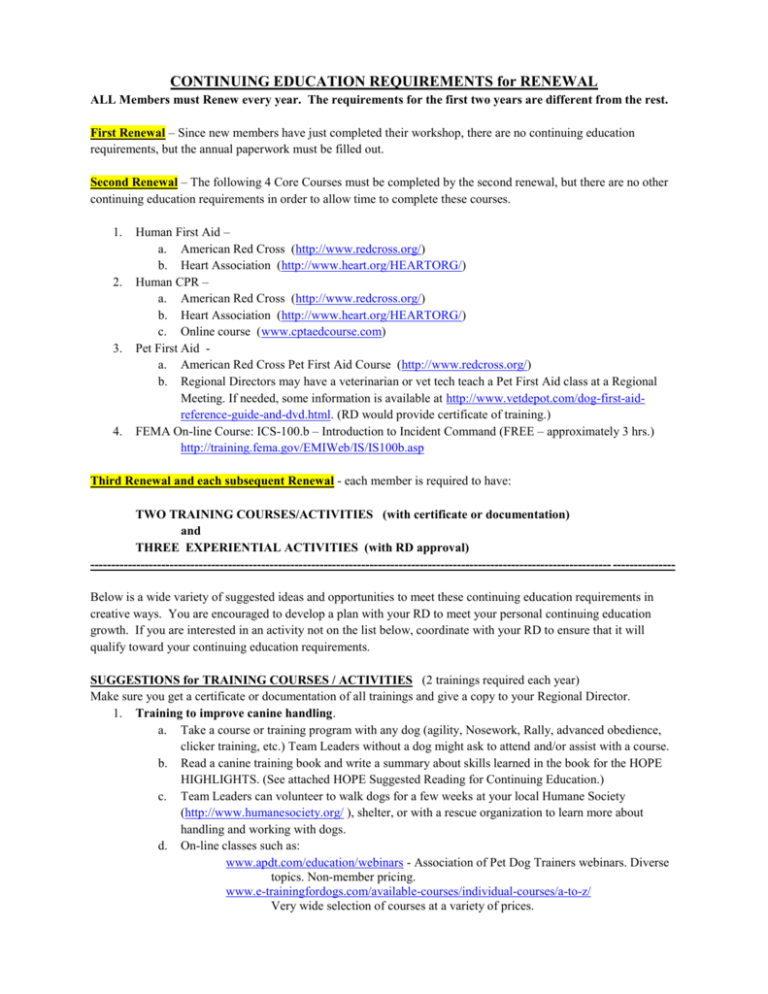
CONTINUING EDUCATION REQUIREMENTS for RENEWAL ALL Members must Renew every year. The requirements for the first two years are different from the rest. First Renewal – Since new members have just completed their workshop, there are no continuing education requirements, but the annual paperwork must be filled out. Second Renewal – The following 4 Core Courses must be completed by the second renewal, but there are no other continuing education requirements in order to allow time to complete these courses. 1. 2. 3. 4. Human First Aid – a. American Red Cross (http://www.redcross.org/) b. Heart Association (http://www.heart.org/HEARTORG/) Human CPR – a. American Red Cross (http://www.redcross.org/) b. Heart Association (http://www.heart.org/HEARTORG/) c. Online course (www.cptaedcourse.com) Pet First Aid a. American Red Cross Pet First Aid Course (http://www.redcross.org/) b. Regional Directors may have a veterinarian or vet tech teach a Pet First Aid class at a Regional Meeting. If needed, some information is available at http://www.vetdepot.com/dog-first-aidreference-guide-and-dvd.html. (RD would provide certificate of training.) FEMA On-line Course: ICS-100.b – Introduction to Incident Command (FREE – approximately 3 hrs.) http://training.fema.gov/EMIWeb/IS/IS100b.asp Third Renewal and each subsequent Renewal - each member is required to have: TWO TRAINING COURSES/ACTIVITIES (with certificate or documentation) and THREE EXPERIENTIAL ACTIVITIES (with RD approval) ----------------------------------------------------------------------------------------------------------------------------- --------------Below is a wide variety of suggested ideas and opportunities to meet these continuing education requirements in creative ways. You are encouraged to develop a plan with your RD to meet your personal continuing education growth. If you are interested in an activity not on the list below, coordinate with your RD to ensure that it will qualify toward your continuing education requirements. SUGGESTIONS for TRAINING COURSES / ACTIVITIES (2 trainings required each year) Make sure you get a certificate or documentation of all trainings and give a copy to your Regional Director. 1. Training to improve canine handling. a. Take a course or training program with any dog (agility, Nosework, Rally, advanced obedience, clicker training, etc.) Team Leaders without a dog might ask to attend and/or assist with a course. b. Read a canine training book and write a summary about skills learned in the book for the HOPE HIGHLIGHTS. (See attached HOPE Suggested Reading for Continuing Education.) c. Team Leaders can volunteer to walk dogs for a few weeks at your local Humane Society (http://www.humanesociety.org/ ), shelter, or with a rescue organization to learn more about handling and working with dogs. d. On-line classes such as: www.apdt.com/education/webinars - Association of Pet Dog Trainers webinars. Diverse topics. Non-member pricing. www.e-trainingfordogs.com/available-courses/individual-courses/a-to-z/ Very wide selection of courses at a variety of prices. 2. Training to improve crisis or disaster response and leadership skills. (You can attend these classes with or without your dog.) Examples: a. Federal Emergency Management Agency (FEMA) Courses offered On-line (FREE) IS-700.a National Incident Management System - An Introduction (FREE - 3 hr.) http://training.fema.gov/EMIWeb/IS/is700a.asp IS-800.b National Response Framework - An Introduction (FREE - 3 hr.) http://training.fema.gov/EMIWeb/IS/IS800b.asp IS-100.b Introduction to Incident Command System (FREE - 3 hr.) http://training.fema.gov/EMIWeb/IS/IS100b.asp IS-200.b ICS for Single Resources and Initial Action Incidents (FREE - 3 hr.) http://training.fema.gov/emiweb/is/is200b.asp IS-10.a Animals in Disaster, Awareness and Preparedness (FREE - 3 hrs.) http://emilms.fema.gov/IS10A/index.htm IS-11.a Animals in Disaster, Community Planning (FREE - 4.5 hr.) http://training.fema.gov/EMIWeb/IS/IS11a.asp b. Community Emergency Response Team (CERT) Classes offered in your local community – (FREE) (http://www.citizencorps.gov/cert/) Contact your local Emergency Management Agency (EMA) regarding the CERT classes sponsored by the US Dept. of Homeland Security. c. American Red Cross (ARC) Disaster Classes (FREE) Contact your local Red cross or check this website for more information. (http://www.redcross.org/) It is recommended that you start with these basic classes. (Some of these classes are only 1 hour long.) 1. Disaster Action Team (DAT) Orientation 2. Fulfilling Our Mission: Translating Your Compassion into Community Action 3. Psychological First Aid 4. Mass Care: An overview 5. Sheltering Operations 6. Shelter Simulation 7. Shelter Drill 8. Client Casework: Providing Emergency Assistance 9. Community Services Overview d. The National Child Traumatic Stress Network offers an on-line course in Psychological First Aid. (http://learn.nctsn.org/course/category.php?id=11) e. Many faith-based groups offer disaster training classes. f. Critical Incident Stress Management (CISM) Classes (Cost varies) The International Critical Incident Stress Foundation (ICISF) website will have information about CISM classes near you. (http://www.icisf.org/) It is recommended you start with the following Core Curriculum Courses. 1. Group Crisis Intervention 2. Individual Crisis Intervention and Peer support 3. Suicide Prevention, Intervention and Postvention 4. Advanced Group Crisis Intervention 5. Strategic Response to Crisis 6. Many additional CISM Specialty Curriculum Courses g. National Organization for Victim assistance (NOVA) (Cost varies) (http://trynova.org/crt/training/) Classes offered in some communities. h. Fire and Earthquake Safety Training (http://rjwestmoretraining.com/) i. Trauma Intervention Programs, Inc. (TIP) (Cost varies) (http://www.tipnational.org/affiliates.htm) Classes offered in some communities. SUGGESTIONS for EXPERIENTIAL ACTIVITIES (3 experiential activities required each year) Any activities where you are wearing your HOPE ID/vest (formally representing HOPE), must have prior RD approval. 1. 2. 3. 4. 5. 6. 7. 8. Attend HOPE AACR Regional Meetings. Attend HOPE AACR National Meetings. Assist at HOPE AACR Screenings. Assist at HOPE AACR Regional Workshops. Participate in Drills. (Write drill report afterward.) Examples: a. CERT drills b. Local Emergency Management drills Participate in a Learning Exercise. (Get permission from RD beforehand and write a report describing what you learned from this activity.) a. Transportation Exercise (rail, boat, airplane, etc) b. Desensitization Exercise c. Other new experiences or training experiences Provide presentation about HOPE AACR. (Get permission and appropriate materials from RD beforehand.) Examples: a. Go to local fire station with your dog and share information about HOPE. Encourage them to call on HOPE as part of mutual aid. b. Go to local college or schools and talk with students / staff in counseling department about HOPE. Encourage them to call on HOPE when needed. c. Contact Medical Reserve Corp (MRC) in local community and ask to speak about HOPE at their next meeting. Encourage them to call on HOPE when needed as part of mutual aid. d. Speak with local church group about HOPE. Encourage them to call on HOPE when needed. e. Speak with local service dog puppy trainers about HOPE. f. Contact local Red Cross Disaster Action Team (DAT) leader. Ask if you can make a HOPE presentation at a DAT meeting. Encourage them to call on HOPE when needed as part of mutual aid. g. Contact local Volunteer Organization Active in Disaster (VOAD) or Community Organization Active in Disaster (COAD). Make presentation about HOPE and encourage them to call on HOPE as part of mutual aid. h. Other presentations about HOPE to inform public or make connections within your local community. Attend meetings as a HOPE representative (with or without your dog). VOAD/COAD Meetings CERT meetings American Red Cross meetings Other meetings with emergency response organizations, mental health organizations, community organizations, etc.
